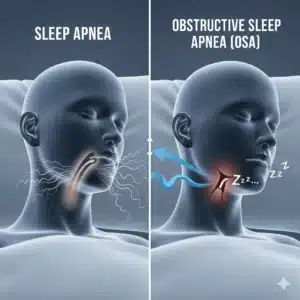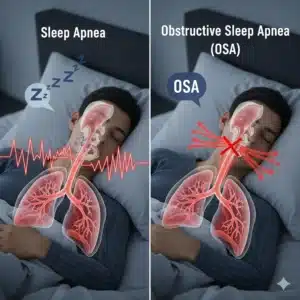Central Sleep Apnea vs OSA Many people hear the terms Sleep Apnea and OSA and wonder: are they the same thing or completely different conditions? This confusion is common, especially for patients who are just starting their journey toward diagnosis and treatment.
In this blog, we’ll compare Sleep Apnea vs OSA, explain the similarities and differences, and guide you through diagnosis and treatment options so you can make the right health decisions.
What is Sleep Apnea?
Sleep Apnea is a sleep disorder where breathing repeatedly stops and starts during sleep. These pauses can last for a few seconds to minutes, causing poor sleep quality and health risks.
Key Symptoms of Sleep Apnea:
- Loud snoring
- Gasping or choking during sleep
- Morning headaches
- Daytime fatigue
- Poor concentration
Sleep Apnea is an umbrella term that covers different types of the condition, including Obstructive Sleep Apnea (OSA) and Central Sleep Apnea (CSA).

What is OSA (Obstructive Sleep Apnea)?
Obstructive Sleep Apnea (OSA) is the most common type of Sleep Apnea. It occurs when the throat muscles relax and block the airway during sleep, leading to disrupted breathing.
Causes of OSA:
- Obesity
- Large tonsils or adenoids
- Narrow airway
- Family history of OSA
- Lifestyle factors (alcohol, smoking, sedatives)
Sleep Apnea vs OSA: The Key Differences
| Factor | Sleep Apnea | OSA (Obstructive Sleep Apnea) |
| Definition | Broad term for all types of apnea | A specific type of Sleep Apnea |
| Types | OSA, CSA, Complex Sleep Apnea | Only OSA |
| Cause | Airway blockage (OSA), brain signaling issues (CSA) | Airway blockage only |
| Symptoms | General sleep apnea symptoms | Same symptoms but directly linked to airway collapse |
| Treatment | Depends on type (OSA, CSA, or both) | CPAP, BiPAP, lifestyle changes, surgery |
Why Does This Difference Matter?
Understanding whether you have OSA or another type of Sleep Apnea is critical because treatment strategies differ. For example:
- OSA often responds well to CPAP therapy or BiPAP machines.
- CSA may require different therapies and close monitoring of underlying conditions.
How is OSA Diagnosed?
The most reliable way to diagnose OSA is through a Sleep Study (Polysomnography) or a Home Sleep Test. These tests measure:
- Breathing patterns
- Oxygen levels
- Heart rate
- Brain activity
Treatment Options for OSA
- Lifestyle changes – weight loss, avoiding alcohol, side-sleeping
- Sleep Apnea Machines – CPAP machines or BiPAP therapy keeps airways open
- Oral appliances – reposition jaw/tongue
- Surgery – for severe or anatomical issues

FAQs (People Also Ask)
Q1. Is Sleep Apnea the same as OSA?
No. Sleep Apnea is a broad term. OSA is the most common type of Sleep Apnea.
Q2. Can you have Sleep Apnea without OSA?
Yes. Central Sleep Apnea (CSA) is Sleep Apnea caused by brain signaling issues, not airway blockage.
Q3. How do doctors test for OSA vs Sleep Apnea?
Doctors recommend a Sleep Study or Home Sleep Test to confirm the type of Sleep Apnea.
Q4. Is OSA more serious than other types of Sleep Apnea?
OSA is common and can be dangerous if untreated, but CSA can also be serious. Both require medical attention.
Q5. Do I need a CPAP machine if I have OSA?
Most patients with moderate to severe OSA are prescribed a CPAP machine to keep their airway open during sleep.
